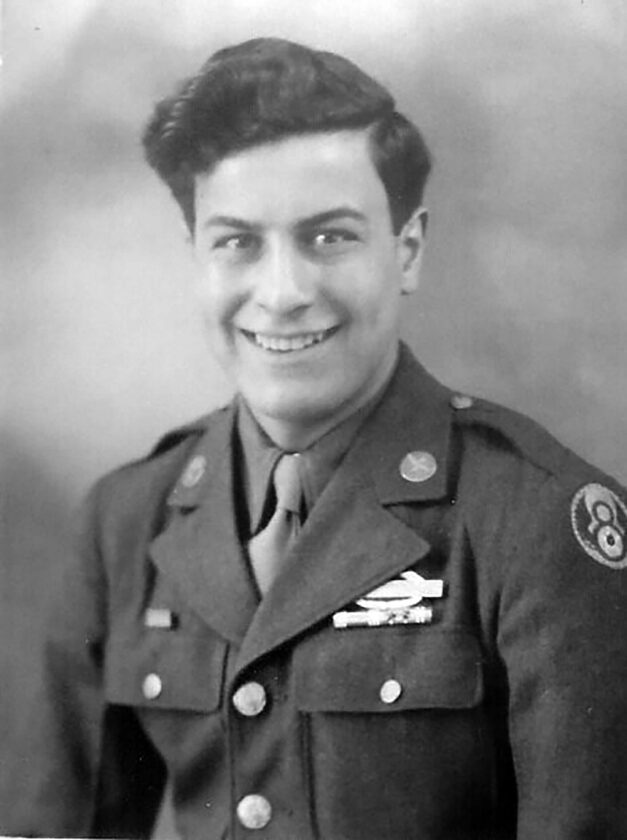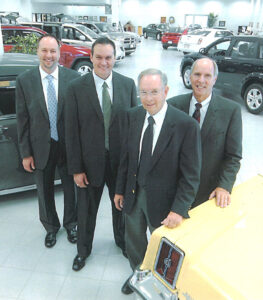A celebration today of Albert Habhab’s 100th birthday
-
Submitted photo
The late Albert Habhab, of Fort Dodge, is shown in his World War II uniform.

Submitted photo
The late Albert Habhab, of Fort Dodge, is shown in his World War II uniform.
As he moved into his 90s, Al Habhab would confide to close friends that he already had made plans to celebrate his 100th birthday with a party at the Fort Dodge Community Orchard on Saturday, Sept. 6, 2025.
“I told Bev and Greg Baedke to reserve that date,” he would say, referring to the previous owners of the orchard (who in 2022 sold it to Denny and Emily Stucky).
It was classic Al Habhab optimism talking – a man who is perhaps the city’s most famous citizen. And he did come close to reaching the century mark. But life, so it’s said, is what happens when you’re making other plans, and Habhab died Jan. 27, 2024, at 98 years of age.
That doesn’t change the fact that the 100th anniversary of his birthday is today. And those who knew Al and his wife of 68 years, Janet, were invited to the Orchard at noon today to share a slice of birthday apple pie and share their favorite stories, then have some lunch.
Al and Janet, who preceded him in death by 18 months, would not be happy with the timing of the informal celebration. It occurs at the same time as the annual Iowa-Iowa State football game being played in Ames. If both were still alive, it’s a safe bet they would have skipped the party and gone to Ames instead.
In one of life’s ironies, Habhab’s 100th birthday occurs just four days after the world celebrated the 80th anniversary of the end of World War II – the Sept. 2, 1945, date when the Japanese formally surrendered aboard the USS Missouri in Tokyo Bay.
Why an irony?
You see, before Habhab was elected as the city’s mayor for 14 years (1960-74), before he served as a district court judge, before he was chief judge of the Iowa Court of Appeals, this son of Lebanese immigrants was a 19-year-old U.S. Army soldier who saved a fellow infantryman’s life during the Battle of the Bulge.
His journey to that pivotal moment in his life happened this way, as he related to this columnist back in 2012 when Al and Janet sat down for a taped interview of their remarkable lives that was later published in book form.
Habhab was a 16-year-old sophomore at Fort Dodge Senior High School when Japan attacked Pearl Harbor on Dec. 7, 1941, and thrust the United States into World War II. Many from Fort Dodge and Webster County went into military service including two of his brothers – Hassan and Oscar – who joined the Navy.
The country was two years into the war when in January 1944, Habhab had enough credits to graduate from FDSH mid-year. Five days after graduation, he was drafted into the Army, on Jan. 25, 1944, and was sent to Camp Croft, South Carolina, for basic training. His mother and sister picked up his diploma at graduation ceremonies in Fort Dodge in May while Habhab was sent to Camp Shelby, Mississippi, for additional training.
He finished training there when he turned 19 and was assigned to the 87th Infantry Division. His Company C, 346th Infantry boarded the Queen Elizabeth for the trip across the Atlantic and he was trained as a rifleman while stationed in England.
It was in November 1944 – 10 months out of high school – when Habhab and his fellow soldiers were sent to France to enter combat in one of the most famous events of WWII – the Battle of the Bulge.
The date of Dec. 16, 1944, was indelibly seared in Habhab’s mind. On that day, facing intense German fire, Habhab’s squad was ordered to take out a machinegun nest. One of the men, Arthur Kingsbury, was hit by bullets and, Habhab recalled, was lying in a field “yelling and screaming, ‘I don’t want to die’ and ‘help me, help me.’ ”
“I told the guys if they would cover me, I would go back and get Kingsbury. So I got rid of my pack but kept my rifle and ammunition belt and crawled on my belly to where Kingsbury was. He was shot up bad and was bleeding profusely. I had my first-aid packs, and I patched him up the best I could. The Germans kept shooting. We could hear the zing of bullets. Finally, the Germans stopped firing. Perhaps they thought we were both dead. There was indeed divine intervention. I threw Kingsbury’s arm over me. He was a big fellow and I was a little guy, I weighed 100-125 pounds. I then dragged him to where the other guys were.”
Some 40 years later, Habhab was able to track down Kingsbury, who was a jeweler in Baltimore, and for many years they exchanged cards or phone calls each Dec. 16 until Kingsbury died. They never got the chance to meet. For his Army service, Habhab was awarded the Bronze Star, three battle stars and the Combat Infantryman Badge.
Habhab developed trench foot a week after rescuing Kingsbury in the frozen conditions of France and was evacuated to a hospital in Paris, and then to England, where doctors were able to save his feet from amputation.
“All I can tell you is that I went into the Army on Jan. 25, 1944. I was in Europe in November 1944. I was in the hospital just a few months later. I lived a lifetime in about 10 months. I was just a common ordinary guy. I never thought much about it until my later years. Although Kingsbury states in his letters that I saved his life, I still believe it was divine intervention. I am not and have not pretended to be a hero.”
The war did not leave the Habhab family untouched. Navy Ensign Oscar Habhab, Al’s brother, was flying a Corsair off an aircraft carrier near Guam, on patrol looking for Japanese planes, when his aircraft went down on April 1, 1945. The plane exploded when it hit the water, and his body was never recovered.
“That was the most devastating thing that fell on our family,” Habhab said. “My parents never recovered from his loss. Our love for him has never closed.”
Habhab was in Army barracks in England the day he received a letter from his sister Mary that Oscar had died: “I was in shock, I didn’t know which way to turn. I guess it’s another incident in my life that perhaps shaped my future.”
Oscar Habhab is memorialized at Tablets of the Missing at Manila American Cemetery in the Philippines.
When the war ended, Habhab was 20 years old and months later was discharged. He returned to Fort Dodge, entered Fort Dodge Junior College and then attended the University of Iowa where he earned his law degree and met a young coed, Janet Morse, on a blind date. She would become his life’s partner.
A life of service to his fellow man was to follow over the next seven decades. All his years were lived in Fort Dodge, the city of his birth and the city he loved.
It was a life that included two children, Robert and Mary Beth, two grandchildren and four great-grandchildren. It was a life that included many honors, including a final one – the city honored him months before his death by renaming the Veterans Memorial Bridge, to be forever known as the Albert Habhab Veterans Memorial Bridge.
And on Saturday, it’s a life to be celebrated.
If Al Habhab were there, he would no doubt offer one of his favorite Irish blessings:
“May the road rise up to meet you. May the wind always be at your back. May the sun shine warm upon your face, and rains fall soft upon your fields. And until we meet again, May God hold you in the palm of His hand.”


